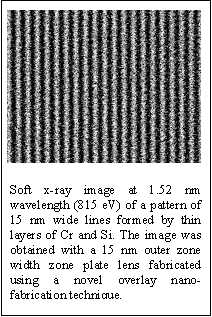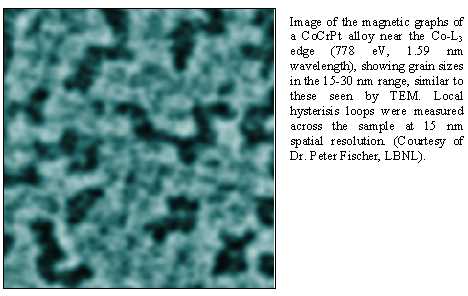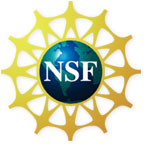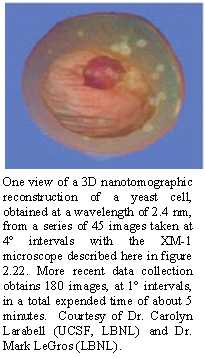Thrust 2: Imaging, Patterning, and Metrology
In this thrust we are exploiting the short wavelength and high coherent attributes of the EUV laser output to implement testbeds for EUV imaging, patterning and metrology. Present activities involve EUV and soft x-ray microscopy, EUV interferometry, EUV print exposures and EUV holographic lithography.

Critical to the use of compact EUV sources in these application testbeds is the development of EUV optical components. Available to the ERC are unique nanofabrication facilities at Lawrence Berkeley Laboratory Center for X-Ray Optics and high quality EUV mirror coating facilities at several of the core institutions.
These efforts provide evidence of the great potential of EUV light in support of nanotechnology.
Recent Results
- Compact 47 nm imaging system reaches 130 nm resolution: (picture below)

- 15nm resolution obtained in imaging experiments using 2.07nm synchrotron light: (picture below)

- State of the art free standing zone plates demonstrated.
- Tabletop patterning tool at 47nm with the capability to print 30nm lines demonstrated: (picture below)

- Demonstration of sub-38 nm resolution imaging with compact EUV source: (picture below)

- High resolution imaging of magnetic material: (picture below)

- Nanotomographic imaging of biological materials: (picture below)
- EUV laser ablation down to 82 nm.
- Dense Plasma Interferometry.
Projects
Demonstration of spatially coherent light in the water window using a compact source for the first time [M. Chen, submitted (2010)] |
 |
3D structural determination from a single view [K. Raines et al., Nature 463 , |
 |
Table-top EUV Zone Plate microscopy with 38 nm spatial resolution using a newly developed high repetition rate 13.2 nm laser and zone plate optics (collaboration between CSU and UC Berkeley). The wavelength of operation falls within the bandwidth of Mo/Si mirrors for EUV lithography, opening up a pathway to table-top at-wavelength metrologies for defect inspection. [F. Brizuela et al., Optics Express 30 , 2095, (2005)] |
 |
Table-top lensless coherent imaging using small-scale coherent EUV sources was demonstrated for the first time , achieving a record resolution of 70 nm. This advance used both high harmonic EUV sources and a compact EUV laser. (Collaboration between CU, CSU, UCLA and UC Berkeley). This result may be of interest for defect inspection) [R. Sandberg et al., Proc. Of the National Academy of Science 105 , 24, (2008); R. Sandberg et al., Physical Review Letters 99 , 098103, (2007)] |
 |
A compact EUV microscope capable of operation in the reflection mode for the inspection of surfaces and nanostructures was also developed using the combination of a 46.9 nm capillary discharge laser, reflective optics and diffractive optics (collaboration between CSU, UC - Berkeley and the Lebedev Physical Institute). In the last year the resolution of this microscope was improved to 54 nm. [G. Vaschenko et al., Optics Letters 30 , 2095, (2005), F. Brizuela et al., Optics Express 30 , 2095, (2005)] |
  |
Demonstration of ultrafast EUV holographic imaging for the first time (collaboration with MIT). [R.I. Tobey et al., Optics Express 32 , 286, (2007)] |
|
Demonstration of a table-top 13.2 nm reflection microscope for actinic mask characterization using EUV laser illumination with a resolution of 55nm (Collaboration between CSU and UC Berkeley). [F. Brizuela et al., Optics Letters 34 , 271, (2009)] |
 |
First demonstration of phase contrast imaging with a spiral zone plate confirming formation of x-ray optical vortices using diffractive optics. [A. Sakdinawat and Y. Liu, Optics Letters 32, 2635 (2007)] |
 |
X-ray Zernike phase contrast imaging using the Zernike zone plate , a single diffractive optical element. [A. Sakdinawat and Y. Liu, Optics Express (2008)] |
 |
Extended depth of field imaging using wavefront coded zone plates demonstrated for 40 nm features. [A. Sakdinawat, et. al., in preparation ] |
 |
Massively parallel x-ray holography using uniformly redundant arrays increases resolution capability for holographic imaging (collaboration with ALS). [S. Marchesini, et. al. Nature Photonics (2008)] |
 |
EUV holograms with 50 nm resolution using a table-top 46.9 nm EUV laser. [P Wachulak et al., Optics Express 14, 9636, (2006)] |
|
Synchrotron radiation based EUV interferometry was advanced to the wave front analysis of a 0.3 NA multilayer coated optics , a factor of three increases in NA with respect to previous experiments. EUV static exposures were printed with 25 nm features for the first time. [K. Goldberg et al., SPIE 5374, 64, (2004)] |
|
Patterning of gratings with periods as small as 55 nm using a 46.9 nm EUV laser. Printing arrays of nanostructures with features as small as 56 nm. [P. Wachulak et al., Journal of the Optical Society of America B 25 , B20, (2008); P. Wachulak et al., Journal of the Optical Society of America B 25 , B104, (2008); P. Wachulak et al., Opto-Electronics Review 16 , 144, (2008); P. Wachulak et al., Optical Society of America B 25 , 1811, (2008); P. Wachulak et al., Optics Express 15 , 10622, (2007); P. Wachulak et al., Optics Express 15 , 3465, (2007); M. Capeluto et al., Microelectronic Engineering 84 , 721, (2007); P. Wachulak et al., Optics Express 14 , 9636, (2006); M. Capeluto et al., IEEE Transactions on Nanotechnology 5 , 3, (2006)] |
 |
| Phase contrast images were obtained for the first time with a new XOR soft x-ray microscope objective that combines both a zone plate and a grating in a single element. The experiments were performed near the Fe-L3 and L2 absorption images of magnetic nanostructures | |
Printing of arrays of arbitrarily shaped nano-patterns by Talbot imaging using a table-top laser illumination [ F. Cerrina et al., submitted (2009)] |
|
| Holographic printing of arbitrary nano-patterns using table-top EUV laser illumination | |
Demonstration of lensless imaging using 30 nm wavelength high harmonic sources with resolutions of 50 nm. This improved the image resolution achieved using HHG by a factor or 2. [R. Sandberg et al., Optics Letters 34 , 1618 (2009 ); Murnane and Miao, Nature 460 , 1088 (2009)] |
 |
Zone plate microscopy using synchrotron radiation was advanced from a spatial resolution of 15 nm in 2005 to a record resolution of 12 nm. [W. Chao et al., Journal of Vacuum Science Technology B 21 , (2003); W. Chao et al., Nature 435 , 1210, (2005); W. Chao et al., (manuscript in preparation)] |
 |
Demonstration of lensless imaging using 13 nm wavelength high harmonic sources for the first time , with resolutions of 90 nm. [D. Raymondson et al. submitted (2010)] |
 |
22 nm printed lines and spaces (dense) for EUV lithography at 13.5 nm wavelength. EUV chemically amplified photoresist is now probing the 20 nm barrier with doses of 15 mJ/cm 2 [P. Naulleau, C. Anderson, SPIE Advanced Lithography 2009] |
 |
Direct x-ray imaging of vortex dynamics in magnetic nanostructures at the Fe L3 edge. Gyrotropic resonant motion of the magnetic vortex core has been observed with 300ps time steps. [B.L. Mesler, M.-Y. Im, P. Fischer, MRS Spring Meeting Poster, San Francisco , (2009)] |
 |
Demonstration of nano-machining with a focus EUL laser (200 nm grooves) (Collaboration between CSU and UC Berkeley). [H. Bravo, CLEO, (2009)] |
 |
Demonstration of dense plasma interferometry using a table-top laser (Collaboration between CSU and Lawrence Livermore National Laboratory). [J. Filevich et al., Applied Optics 43, 3938, (2004); J. Filevich et al., Physical Review Letters 94, 035005, (2005); J. Filevich et al., J. Quant. Spec. and Rad. Trans. 99, 165, (2006); J. Filevich et al., Physical Review E 74, 016404, (2006); J. Filevich et al., Laser Particle Beams 25, 47, (2007)] |
 |
For more information see: Lawrence Berkeley National Laboratory and Carmen Menoni's Homepage






